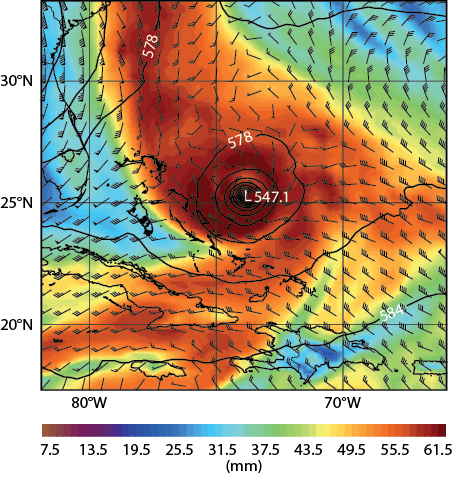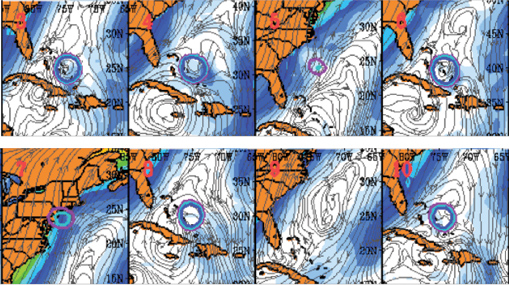ECMWF forecasts have helped researchers in the United States to plan the deployment of aircraft in a field experiment on tropical cyclone intensity and structure change. The 2015 Tropical Cyclone Intensity field experiment (TCI-15), funded by the US Office of Naval Research, sampled the upper-level outflow of tropical cyclones in order to reveal new insights into the role that outflow might play in intensity change.
The field experiment involved the deployment of the NASA WB-57 aircraft, which possessed a unique capability to fly over the cyclones and deploy up to 80 dropwindsondes per mission. Two noteworthy cases were Hurricane Joaquin in the Atlantic basin, which possessed unusually high uncertainty in its forecast, and Hurricane Patricia in the eastern Pacific basin, which was the most intense tropical cyclone ever recorded in the western hemisphere.
Hurricane Joaquin
On 27 September 2015, the TCI team’s focus had been on Hurricane Marty near Mexico. However, the 00 UTC ECMWF ensemble began to suggest that a loosely organised cluster of thunderstorms north of the Dominican Republic had the potential to develop into a tropical cyclone. This indication helped convince the TCI team to forward deploy the aircraft, crew and equipment to Georgia in the eastern United States, in order to prepare for missions over the disturbance that ultimately became Hurricane Joaquin.
The consistency in ECMWF’s high-resolution and ensemble output over this period led to increased confidence that this would be an excellent case. Four WB-57 missions over Joaquin were conducted between 2 and 5 October, including the period when Joaquin was a Category 4 hurricane. ECMWF’s high-resolution forecasts were the earliest of all forecasts from operational models to capture the correct track of the hurricane.



Beyond the decision of whether or not to deploy, additional decisions on how to design the flight tracks were also necessary. To address the scientific goal of understanding the role of the upper-tropospheric outflow in tropical cyclone intensity change, new products based on ensemble forecasts were developed and used. These products demonstrated the range of scenarios, not only of the position and strength of the hurricane, but also of the configuration of the outflow.
Hurricane Patricia
ECMWF’s high-resolution and ensemble forecasts were also used to guide the planning of the historic missions into Hurricane Patricia, which possessed a minimum sea-level pressure of 872 hPa and a maximum sustained wind speed of 95 m/s on 23 September 2015. The time-sensitive decision on deployment, which resulted in four successful WB-57 missions, can again be attributed in large part to the quality of the forecast guidance.

Conclusion
The TCI-15 field experiment benefited substantially from ECMWF’s forecasts, which were the central predictions used during the daily weather briefings. Especially due to the complicated logistics of forward deployment, which needed to be initiated several days prior to the missions, accurate estimations of the likelihood of a significant tropical cyclone for sampling were necessary. The retrospective consensus view of the TCI-15 team is that all the decisions on deployment (or non-deployment) turned out to be the correct call, which speaks to the effectiveness of the model guidance.
The TCI team are grateful for the excellent support provided by the ECMWF Data Services team, and the reliable timely transfer of the data. Now that the field experiment has concluded, investigators are using the data to address scientific questions related to the dynamics and predictability of tropical cyclones.

